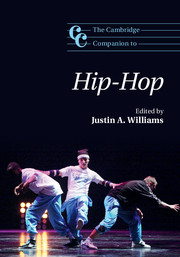Acknowledgments
This book was a nerdy dream of mine, the kind that young academics have when they get enthusiastic about an academic book series they “grew up” with. As a student, then as an educator, my copies of books such as The Cambridge Companions to Jazz, Beethoven, Rock and Pop, and Schubert are well worn, and used year on year for numerous purposes. Victoria Cooper helped make my nerdy dream a reality. Special thanks to her and to Fleur Jones and Emma Collison at the press for their patience and advice. I would also like to thank all the contributors to the volume and for their enthusiasm for the project. Many of the authors are scholars whom I met at conferences where we ended up having long and passionate discussions about hip-hop, and I thank them for always reinvigorating me with passion for the topic. I’d like to think we are the Wu-Tang Clan of hip-hop academics, a diverse collective with different skills that has created a force more powerful than the sum of its parts.
Many authors were able to use their personal interviews with a number of practitioners and scholars (Amiri Baraka, Doze Green, MC Lars, MC Frontalot, Compton Virtue, to name a few) and I want to thank all the interviewees and those who gave permission to use photos for the volume. Special thanks to Belinda Lawley for letting us use two of her photos from the Breakin’ Convention in Sadler’s Wells for both the front and back covers, and thanks to Dave Barros at Sadler’s Wells for finding them in the archives. I would also like to thank my students at Bristol University who took my Hip-hop Music and Culture class in spring 2014. The class provided a useful forum to test and discuss many of the ideas that follow. Thanks to my wife Katherine for her support, as always.
A large debt, personally and professionally, is owed to my former Ph.D. supervisor. All who study hip-hop, but especially those who analyze hip-hop music, are indebted to the work of the late Adam Krims. As Kyle Adams rightly states in his chapter: “No one contributed quite as much to the analysis of hip-hop as Adam Krims; in fact, analytical approaches can productively be divided into ‘Krims’ and ‘Other’.” Professor Krims had agreed to contribute two chapters to this volume (one on Russian rap and another on geography), but passed away suddenly in September 2012. Professor Krims’s work has touched everyone working on hip-hop scholarship and thus looms as an important presence and influence on this book and the entire field. He had an extremely important professional influence on me, and I am happy to say he was also a friend. The book is very much dedicated to his memory.

